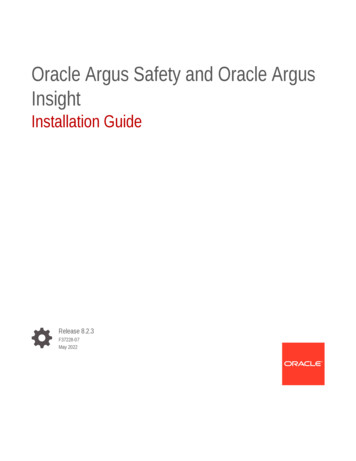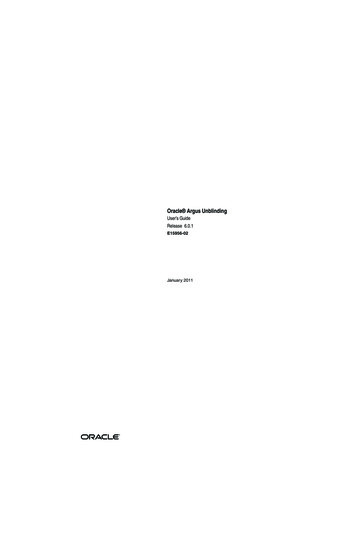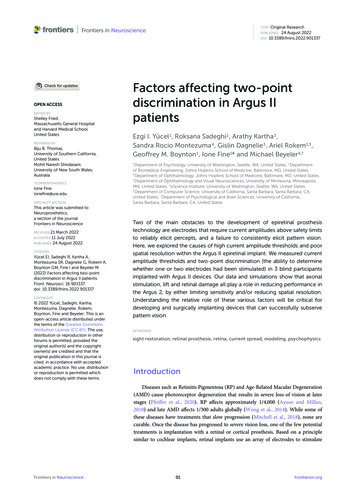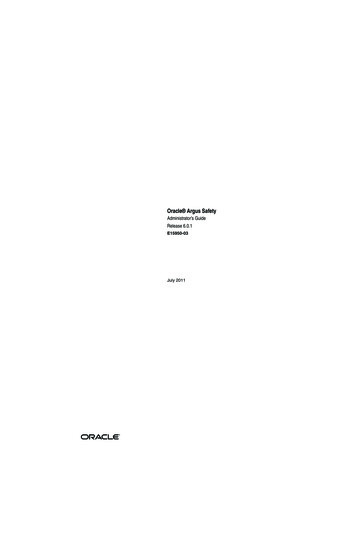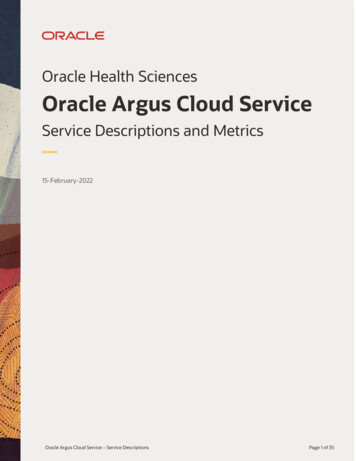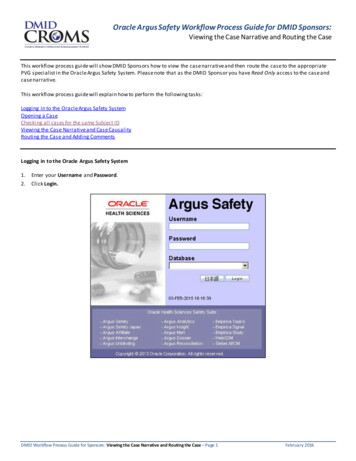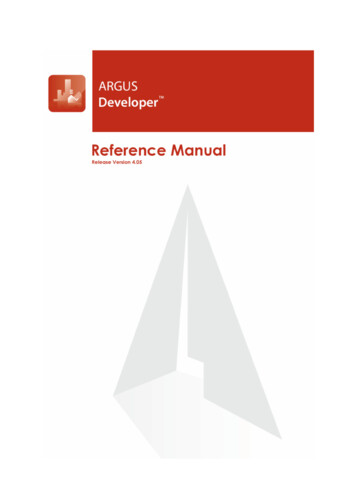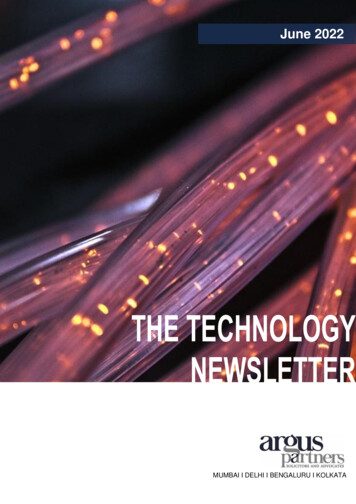
Transcription
June 2022THE TECHNOLOGYNEWSLETTERMUMBAI I DELHI I BENGALURU I KOLKATA
INTRODUCTIONThe Argus Technology Newsletter discusses recent developments in technologicaladvances or milestones or events. As lawyers, we enjoy delving into the legal nuancesand implications of technological changes and analysing their impact on our clients andtheir activities. It is said that law always lags behind technological advances and therecould be some truth behind such statement, but there is no reason for lawyers to lagbehind technological advances.The Argus Technology Newsletter is not meant to be a substitute for your regulartechnology periodical. Instead, we hope and promise to offer a lawyer’s insights intotechnological change and innovation.Argus Partners has a developed a strong and a robust technology and data privacypractice, which spans transactional advisory, corporate and regulatory advisory as wellas contentious matters and disputes. Whilst physically the attorneys are based out ofour Mumbai, Delhi & Bangalore offices, the team is servicing clients across the globeon Indian legal issues in technology and data privacy.For Private Circulation1 P a g e
Independent Research Institute Calls for New UK Laws onUse of BiometricsArticle Contributed by Aryan Mohindroo (Associate)A recent independent review by the Ada Lovelace Institute has revealed that the UKis in urgent need of new laws to govern the use of biometric technologies. The reviewhas called on the UK government to introduce new legislation for their governance.The legal review has provided 10 (ten) recommendations for regulating the use ofbiometrics by UK investigative agencies. These recommendations include suspensionof the public use of live facial recognition technologies until a legally binding code ofconduct is established to govern its use. The review also recommends the enactmentof a wider, technology-neutral legislation to establish a statutory framework to governthe use of biometrics for law enforcement.The Ada Lovelace Institute's review has found that biometric data is being used in agrowing number of applications in everyday parts of society and everyday lives. Thisuse goes beyond the traditional uses of biometric data in law enforcement and into allareas of citizens’ lives.The hue and cry relating to the unrestricted use of live facial recognition technologyby several UK police forces have persisted for long. Around this time last year, eventhe UK Information Commissioner went public about the unrestricted and reckless useof live facial recognition in public places. Pursuant to such recurrent complaints aboutthe use of the technology, the Information Commissioner’s Office (“ICO”) also fined acontroversial U.S. based company Clearview AI, which engages in development offacial recognition technologies. The Company used selfies available on the internetwithout consent to run an AI based identification matching service. It was ordered todelete UK Citizens’ data as well.For Private Circulation2 P a g e
RBI Publishes Draft Master Direction on Outsourcing of ITServicesArticle Contributed by Smriti Tripathi (Senior Associate)Regulated Entities (“REs”) such as banks and NBFCs have been extensively leveragingInformation Technology (“IT”) and IT-enabled services (“ITeS”) to support their businessmodels and products and services offered to their customers. REs also outsource asubstantial portion of their IT activities to third parties. Such reliance on IT/ ITeS provided bythird parties exposes the REs to significant risks.In order to ensure effective management of attendant risks in outsourcing of IT activities, theReserve Bank of India (“RBI”) has proposed to prescribe a master direction on outsourcing ofIT services to be implemented by the REs. The RBI, on June 23, 2022, published the draftMaster Direction on Outsourcing of IT Services (“Draft MD”) for comments of stakeholdersand members of the public, which may be submitted by July 22, 2022. The RBI shall issue thefinal Master Direction after considering the feedback received from the stakeholders.The Draft MD has been issued by RBI in the exercise of the powers conferred by Section 35Aread with Section 56 of the Banking Regulation Act, 1949, Section 45L of the Reserve Bankof India Act, 1934 and Section 11 of the Credit Information Companies (Regulation) Act, 2005and provides a risk management framework for the outsourcing of IT Services, managingrelated concentration risk, its periodic risk assessment and aspects of outsourcing of ITServices to foreign service providers.In the Draft MD, 'Outsourcing of IT Services’ has been defined as an RE’s use of a serviceprovider to perform any of the activities listed below on a continuing basis. ‘Continuing basis’would include agreements for a limited period. Outsourcing of IT Services mainly covers thefollowing areas but is not limited to:(a) IT infrastructure management, maintenance and support (hardware/ software/firmware);(b) Network and security solutions maintenance (hardware/ software/ firmware);(c) Application Development, Maintenance and Testing;(d) Services and operations related to Data Centres;For Private Circulation3 P a g e
(e)(f)(g)(h)Cloud Computing Services;Managed Security Services;Application Service Providers (ASPs) including ATM Switch ASPs5; andManagement of IT infrastructure and technology services associated with paymentsystem ecosystem.The provisions of the Master Direction (once finalized) shall be applicable to the following REs:Scheduled Commercial Banks (excluding Regional Rural Banks), Local Area Banks, SmallFinance Banks, Payments Banks, Primary (Urban) Co-operative Banks having asset size of 1000 crore and above, Non-Banking Financial Companies in Top, Upper and Middle Layers,Credit Information Companies and All India Financial Institutions (NHB, NABARD, SIDBI,EXIM Bank and NaBFID).The Draft MD provides for the following in detail:(a) RE’s role in outsourcing IT services;(b) governance framework for approving an IT outsourcing policy and role of the Boardand senior management;(c) evaluation and engagement of service providers by the REs;(d) provisions to be contained in an outsourcing agreement;(e) risk management framework to be adopted by the REs;(f) business continuity plan and disaster recovery plan to be implemented by serviceproviders;(g) monitoring and control of outsourced activities by the REs;(h) outsourcing within a group/conglomerate of the RE;(i) additional requirements for cross-border outsourcing; and(j) exit strategy enabling the REs to terminate the services of the service provider.The underlying principle of the Master Direction is that the RE should ensure that outsourcingarrangements neither diminish its ability to fulfill its obligations to customers nor impedeeffective supervision by the supervising authority. REs desirous of outsourcing IT and ITenabled services shall not require any approval from RBI. However, such arrangements shallbe subject to on-site/ off-site monitoring and inspection/ scrutiny by the supervising authority.In view of the increasing use of IT/ITeS services by banks/NBFCs and the inevitable need tooutsource such services in today’s digital world, it is pertinent to put in place a frameworkaround outsourcing of IT services by banks/NBFCs. As such, publishing of the draft masterdirections by the RBI is a welcome step. Once finalized, the master directions will go a longway in ensuring that banks/NBFCs can provide fast, reliable and efficient service to thecustomers while at the same time managing/containing the risks associated with outsourcingIT services to third parties.The draft MD may be accessed here.For Private Circulation4 P a g e
‘Intermediaries are Duty Bound to Regulate Content’ –Madras High Court ObservesArticle Contributed by Niharika Sharma (Associate)By an order dated June 7, 2022 passed in State represented by the Inspector of Police v. A.Duraimurugan Pandiyan Sattai (‘Decision’), the Madurai Bench of Madras High Court (‘Court’)analyzed the liabilities and obligations of intermediaries, and observed that the intermediariesare obligated to regulate content over the internet.Brief factsIn this case, the Court was examining a petition filed by a police official under Section 439(2)(3)of the Code of Criminal Procedure, 1973 (‘Cr.P.C’) seeking cancellation of bail granted to oneA. Duraimurugan Pandiyan Sattai, for posting offensive videos over ‘YouTube’ with certainderogatory remarks against various persons including the former Chief Minister of Tamil Nadu.Even though the aforesaid petition was filed under the provisions of Cr.P.C, the Court delvedinto the provisions of Sections 69A, 79(3)(b) and 84B of the Information and Technology Act,2001 (‘IT Act’), and noted that whenever a request for blocking content is made by the CentralGovernment/ its officials or as per the community guidelines framed by each intermediary, itis the liability of such intermediary to block content for public access.Findings of the CourtWhile allowing the petition for cancellation of bail to Mr. Sattai, the Court observed thatSections 69A, 79(3)(b) and 84B of the IT Act impose certain duties and liabilities on theintermediaries. In addition to this, various intermediaries have framed their respectivecommunity guidelines for the regulation of content on social media, in this case, ‘The YouTubeCommunity Guidelines’. Having framed guidelines for its users, it is the duty of theintermediaries to remove or block the channel of any such violator.The Court further observed that ‘it is the duty of intermediaries to ascertain whether thosevideos are in accordance with their policies and guidelines and in terms of the contract and toFor Private Circulation5 P a g e
block the channels if the videos are not in accordance with the terms and policies. Theintermediaries are not expected to insist for FIR or any court orders to remove the videoswhich are in violation of their guidelines. If it is not blocked or removed even after it was broughtto their knowledge, the intermediaries are committing the offence under Section 69A (3) of theInformation Technology Act’.The Court sought a reply from the Tamil Nadu government as to whether social mediacompanies can be included as an accused or an abettor in criminal cases involving socialmedia platforms. The Court also asked if the government had any mechanism throughwhich such misuse could be prevented and appointed advocate KK Ramakrishnan asamicus curiae to assist the Court on the issue.AnalysisThe Decision makes certain sweeping observations which have once again broughtintermediaries under the spotlight. The Information Technology (Intermediary Guidelines andDigital Media Ethics Code) Rules 2021 (‘IT Rules’) are already under the scrutiny of theSupreme Court and on June 6, 2022, the Central Government had invited public commentsand consultation from stakeholders on the proposed amendments to the IT Rules which, interalia, require significant social media intermediaries to remove from the internet any contentwhich is obscene, pornographic, invasive of bodily privacy and racially or ethnicallyobjectionable, within 72 hours, as opposed to the current 15 days.It remains to be seen how an appellate court would react if the Decision is appealed against.For Private Circulation6 P a g e
Proposed Amendments to IT Rules, 2021Article Contributed by Akshay Bhatia (Associate)On June 6, 2022, the Ministry of Electronics and Information Technology (“MeitY”), proposedamendments to the Information Technology (Intermediary Guidelines and Digital Media EthicsCode) Rules, 2021 (“IT Rules, 2021”) to ‘address challenges and gaps’ that exist in the ITRules vis-a-vis Big Tech platforms (“Proposed Amendments”).These Proposed Amendments are part of the pre-legislative consultation process and havebeen uploaded on MeitY's website for public feedback and input from all stakeholders for aperiod of 30 days from the date of publication.The Proposed Amendments entail the following:1. Creation of a ‘Grievance Appellate Committee’: MeitY aims to create GrievanceAppellate Committee(s) (“GAC”) by introducing Rule 3(3), IT Rules, 2021. A GAC shallserve as an appellate to whom appeals shall lie from an order made by the grievanceofficer (“GO”) under Rule 3(2)(a) and (b), IT Rules, 2021 within 30 days from the receiptof the communication from such GO. It is proposed that such GAC shall aim to disposeof an appeal within 30 working days from the receipt of the appeal and once an orderis passed by the GAC passed, such shall be complied by the concerned intermediary.The rationale given for such setting up of such a GAC is that it provides users analternative to file an appeal against the order of a GO instead of approaching judicialremedy by way of a court of law. It has also been stated that judicial remedy shall beopen to a user at any time against any order of an intermediary or a GO.2. Ensuring compliance with Rule 3(1)(b) by intermediaries: Rule 3(1)(b), IT Rules2021 requires intermediaries to inform their users, through privacy policies, rules andagreements etc. not to post content that is ‘defamatory’, ‘harmful to child, ’deceiving ormisleading’, ‘in violation of any law’ etc. At present, an intermediary is not mandatedto remove content falling under Rule 3(1)(b), IT Rules 2021 in the absence of acomplaint by a user. The Proposed Amendments, by amending Rule 3(1)(a) and (b),IT Rules, 2021 aim to mandate the removal of objectionable content falling under Rule3(1)(b), IT Rules 2021 by the intermediary itself, even in the absence of a complaintFor Private Circulation7 P a g e
by a user. This shifts the burden of compliance on the intermediary, might be difficultto implement and may result in arbitrary and uneven enforcement.3. Grievance Redressal within 72 hours: The Proposed Amendments, by adding twoprovisos to Rule 3(2), IT Rules, 2021 requires an intermediary, through its GO, toaction and redress a complaint for removal of content within 72 hours of the requestbeing made. The rationale given for this is that by the very nature of the internet andits ensuing outreach, pace and virality, content removal complaints should beredressed in a timely manner. It also states that intermediaries may developsafeguards to avoid the misuse of the redressal system by users that submitinappropriate, trivial or inauthentic complaints.4. Respect to constitutional rights: Through Rule 3(1)(m) and (n) of the ProposedAmendments, MeitY requires an intermediary to respect the constitutional rightsaccorded to the citizens of India under the Constitution. It also requires intermediariesto take reasonable measures to ensure accessibility of its services to all users and toensure users have a reasonable expectation of due diligence, privacy andtransparency.The Proposed Amendments may increase the burden of compliance on intermediaries.According to compliance reports, Facebook1 already removes/ takes down around 3 crorepieces of content on a monthly basis in India. The widened scope of objectionable contentand increased burden of ensuring compliance even in the absence of a user complaintwould require intermediaries to dedicate more resources and be vary of running afoul ofthe IT Rules, 2021. The introduction of the GAC to hear appeals from orders of the GOsmay result in undue governmental interference in freedom of speech accorded underArticle 19 of the Constitution and may result in censorship firstly by the intermediaries andthen by the GAC, which is constituted by the central government.The IT Rules, 2021, since their very implementation, have been the subject of litigationbefore various high courts around the country. Notably, the Bombay High Court and theMadras High Court have stayed Part III, IT Rules, 2021 on the grounds that they areviolative of the right to speech and are beyond the rule making powers of the centralgovernment, while the Kerala High Court has also passed interim orders stating that nocoercive steps shall be taken under the IT Rules, 2021 while the matter is pending beforethe court. The Supreme Court of India, hearing appeals from orders of various high courts,has stayed said proceedings before the high courts and agreed to hear challenges to ITRules, 2021 cumulatively on July 19, snx8QqohdES79s5OntuKT/viewFor Private Circulation8 P a g e
Proposed Changes to UK’s Data Protection RegimeArticle Contributed by Anushkaa Shekhar (Associate)The UK first indicated its intention to overhaul its data protection regime when it published itsnew National Data Strategy on September 9, 2020, nearly eight months after the BrexitWithdrawal Agreement came into force and the transition period began. The 11-monthtransition period ended on December 31, 2020 and the UK formally and effectively left the EUon January 1, 2021. On this date, the Data Protection, Privacy and Electronic Communications(Amendments etc) (EU Exit) Regulations, 2019 came into force which called for adomestication of the EU General Data Protection Regulation (“EU GDPR”). The UK thenintroduced the UK GDPR, which combined the two previously existing regimes for personaldata protection, notably the EU GDPR and the Data Protection Act, 2018. At this point, the UKGDPR was a replica of the EU GDPR and was amended only to substitute some parts of thetext from ‘EU and Union law’ to ‘UK and domestic law’.But when the Department for Digital Culture, Media & Sport published its consultation onproposed reforms to the UK’s data protection regime (the “Consultation”) on September 10,2021, it constituted a major departure from current UK legislation and the EU GDPR. Thissignificant shift was described as ‘a clampdown on bureaucracy, red tape and pointlesspaperwork’ that comes along with the EU data protection law. Responses to the consultationswere accepted for a period of 10 weeks till November 19, 2021. The response to theConsultation (“Draft Proposal”) was released on June 17, 2022. The voluminous documentis the result of approximately 3,000 public replies and more than 40 roundtable discussionswith stakeholders from academics, technology, and industry, as well as consumer rightsgroups. Some of the major reforms that are in the offing are:1. Introduction of Privacy Management Programmes (“PMP”)Key components of the current accountability system are to be replaced by a moreadaptable, risk-based Privacy Management Programme. The programme’scomprehensiveness will be determined by the volume and sensitivity of personal datahandled by an organization.1.1.The PMP approach would be based on a number of elements at the core ofaccountability, such as:For Private Circulation9 P a g e
leadership and oversightrisk assessmentpolicies and processestransparencytraining and awareness of staffmonitoring, evaluation and improvement1.2.To support the implementation of PMPs, the government has proposed the removal ofcertain requirements under the UK GDPR: Removal of Data Protection Officers (“DPO”): The post of DPOs, whose role was tooversee the organization’s data protection strategy, has been done away. Instead,appointment of a suitable senior individual who will be responsible for the PMP isenvisaged. The role has not yet been fully particularised, but it seems likely to be lessformal than that of DPO and without the independence requirements.Removal of Data Protection Impact Assessments (“DPIA”): Organizations will nolonger be required to undertake DPIA. Rather, the Draft Proposal stipulatesimplementation of risk assessment tools which help assess, identify and mitigate risks.Relaxation under Article 30: Lastly, the Draft Proposal has removed the requirementto keep a record of processing activities based on Article 30 of the EU GDPR. Theorganizations have been given more flexibility in their record keeping requirement.2. Placing cookies without user’s consentUnder current regulations, cookies are not permitted to be placed on a device without theuser’s consent, which is usually sought through a pop-up notice. However, now thegovernment intends to permit cookies to be placed on a user’s device without explicitconsent, for some non-intrusive purposes, like audience measurement cookies. Gradually,the government aims to switch to an opt-out model of consent for website cookies. Thismeans that cookies can be set without the user's knowledge, but the website will have toprovide explicit instructions on how to opt out. However, the opt-out model would not applyto websites likely to be accessed by children.3. Change in the functioning of Information Commissioner’s Office (“ICO”)Under the EU GDPR, ICO is the independent regulatory office in charge of upholdinginformation rights in the interest of the public. However, as per the Draft Proposal, thesecretary of state will now set out a statement of strategic priorities for the ICO, which willfirst have to be approved by parliament. The ICO will be required to respond to thesepriorities but will not be legally bound to act in accordance with the statement. The ICO’sgovernance will also be reformed and it will be renamed.4. Change in threshold for subject access requestThe current regime provides for subject access requests, which means that the individualshave the right to access and obtain a copy of their personal data, as well as other relatedinformation from an organization. The organizations have the right to deny subject accessrequest if they deem the request to be ‘manifestly unfounded or excessive’. The DraftProposal aims to change this to threshold to ‘vexatious or excessive’.These proposed reforms are likely to form the basis of the forthcoming UK Data Reform Bill.While the aim of the government was to simplify the data protection regime by bringing inthese reforms, it may actually make things difficult for UK based companies. When sellinggoods and services to the EU, enterprises situated in the UK will have to follow EU data privacyregulations. As a result, many businesses may not benefit from the simpler legislation that isbeing proposed for the UK and will have to juggle a dual track regime.For Private Circulation10 P a g e
DISCLAIMERThis document is merely intended as an update and is merely forinformational purposes. This document should not be construed as a legalopinion. No person should rely on the contents of this document withoutfirst obtaining advice from a qualified professional person. This document iscontributed on the understanding that the Firm, its employees andconsultants are not responsible for the results of any actions taken on thebasis of information in this document, or for any error in or omission fromthis document. Further, the Firm, its employees and consultants, expresslydisclaim all and any liability and responsibility to any person who reads thisdocument in respect of anything, and of the consequences of anything, doneor omitted to be done by such person in reliance, whether wholly orpartially, upon the whole or any part of the content of this document.Without limiting the generality of the above, no author, consultant or theFirm shall have any responsibility for any act or omission of any other author,consultant or the Firm. This document does not and is not intended toconstitute solicitation, invitation, advertisement or inducement of any sortwhatsoever from us or any of our members to solicit any work, in anymanner, whether directly or indirectly.You can send us your comments at:argusknowledgecentre@argus-p.comMumbai I Delhi I Bengaluru I Kolkatawww.argus-p.comFor Private Circulation11 P a g e
Key Contacts for the Data Privacy and Technology PracticeVinod Joseph, Partnervinod.joseph@argus-p.comFor Private CirculationUdit Mendiratta, Partnerudit.mendiratta@argus-p.com12 P a g e
DELHIExpress Building9-10, Bahadurshah Zafar MargNew Delhi 110002T: 91 11 2370 1284/5/7MUMBAI11, Free Press House215, Nariman PointMumbai 400021T: 91 22 6736 2222BENGALURU68 Nandidurga RoadJayamahal ExtensionBengaluru 560046T: 91 80 46462300KOLKATABinoy Bhavan3rd Floor, 27B Camac StreetKolkata 700016T: 91 33 40650155/56www.argus-p.com I communications@argus-p.comFor Private Circulation13 P a g e
areas of citizens' lives. The hue and cry relating to the unrestricted use of live facial recognition technology by several UK police forces have persisted for long. Around this time last year, even the UK Information Commissioner went public about the unrestricted and reckless use of live facial recognition in public places.
